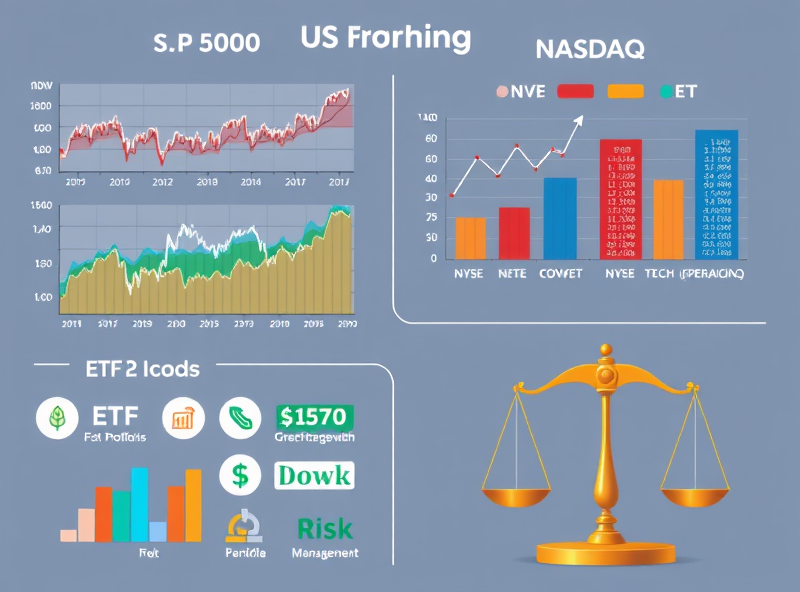Index ETFs: The Foundation of Market Diversification

When it comes to building a strong and diversified investment portfolio, Index ETFs (Exchange-Traded Funds) are often considered the cornerstone. These ETFs aim to replicate the performance of a specific market index, such as the S&P 500 or the NASDAQ-100, providing investors with broad market exposure at a relatively low cost. The beauty of Index ETFs lies in their simplicity and efficiency. By investing in a single Index ETF, you can gain access to hundreds or even thousands of stocks, spreading your risk across various sectors and companies. This makes them an excellent choice for both beginner and seasoned investors who want to minimize risk while still participating in market growth. Additionally, Index ETFs are known for their low expense ratios compared to actively managed funds, which means more of your money stays invested and working for you. Whether you’re saving for retirement, a major purchase, or simply looking to grow your wealth, Index ETFs offer a reliable and straightforward way to achieve your financial goals.
Sector & Thematic ETFs: Focused Investment Opportunities

When it comes to investing in ETFs, sector and thematic ETFs offer a unique opportunity to target specific industries or trends. These ETFs allow investors to focus their investments on particular sectors like technology, healthcare, or energy, or even on broader themes such as renewable energy, artificial intelligence, or clean water. By doing so, they provide a way to align your portfolio with your personal interests or beliefs while potentially capitalizing on emerging trends.
Sector ETFs are particularly useful for those who want to take advantage of the growth in a specific industry. For example, a technology sector ETF could include companies like Apple, Microsoft, or NVIDIA, offering exposure to the booming tech industry. On the other hand, thematic ETFs are designed to capture broader trends that span multiple sectors. For instance, a thematic ETF focused on renewable energy might include companies involved in solar, wind, and battery technologies.
One of the key benefits of these ETFs is diversification within a focused area. Instead of investing in individual stocks, which can be risky, sector and thematic ETFs spread your investment across multiple companies within the same theme or sector. This reduces the risk of relying on the performance of a single company.
However, it’s essential to do your research before investing. Understand the underlying assets, expense ratios, and the potential risks associated with the sector or theme you’re targeting. Additionally, consider how these ETFs fit into your overall investment strategy and risk tolerance. By making informed decisions, sector and thematic ETFs can be a powerful tool to help you achieve your financial goals while staying aligned with your interests.
Bond & Dividend ETFs: Stability and Income Generation

Investing in Bond and Dividend ETFs can be a smart strategy for those seeking both stability and consistent income. Bond ETFs primarily invest in fixed-income securities like government or corporate bonds, offering a predictable income stream with relatively lower risk. They are an excellent choice for conservative investors or those nearing retirement who prioritize capital preservation. On the other hand, Dividend ETFs focus on stocks of companies that regularly pay dividends. These ETFs are ideal for investors looking to generate passive income while benefiting from potential capital appreciation. By combining these two types of ETFs in your portfolio, you can achieve a balanced mix of stability and income generation. Always remember to assess the expense ratios, historical performance, and the underlying assets of the ETFs before investing. This thoughtful approach can help you align your investments with your financial goals and risk tolerance.
Advanced ETFs: Leveraged, Inverse, and Commodity Options

Exchange-Traded Funds (ETFs) have revolutionized the way we invest, offering simplicity, diversification, and accessibility. However, as you advance in your investing journey, you might encounter specialized ETFs like leveraged, inverse, and commodity ETFs. These advanced options can provide unique opportunities, but they also come with higher risks. Let’s break them down so you can make informed decisions.
**1. Leveraged ETFs:** These ETFs aim to amplify the daily returns of an underlying index, often by 2x or 3x. For example, if the S&P 500 rises by 1% in a day, a 2x leveraged ETF would aim to rise by 2%. While this can lead to significant gains, it’s important to note that leveraged ETFs are designed for short-term trading and not long-term holding due to the effects of compounding.
**2. Inverse ETFs:** Inverse ETFs are designed to perform in the opposite direction of their underlying index. If the index falls by 1%, the inverse ETF aims to rise by 1%. These are often used by investors to hedge against market downturns or to profit from declining markets. Like leveraged ETFs, they are best suited for short-term strategies.
**3. Commodity ETFs:** These ETFs provide exposure to physical commodities like gold, oil, or agricultural products. They can be a great way to diversify your portfolio and hedge against inflation. However, it’s crucial to understand the underlying asset and market dynamics, as commodity prices can be highly volatile.
When considering these advanced ETFs, always assess your risk tolerance, investment goals, and time horizon. They can be powerful tools when used wisely, but they require a solid understanding of their mechanics. Remember, investing is a journey, and continuous learning is key to success.



